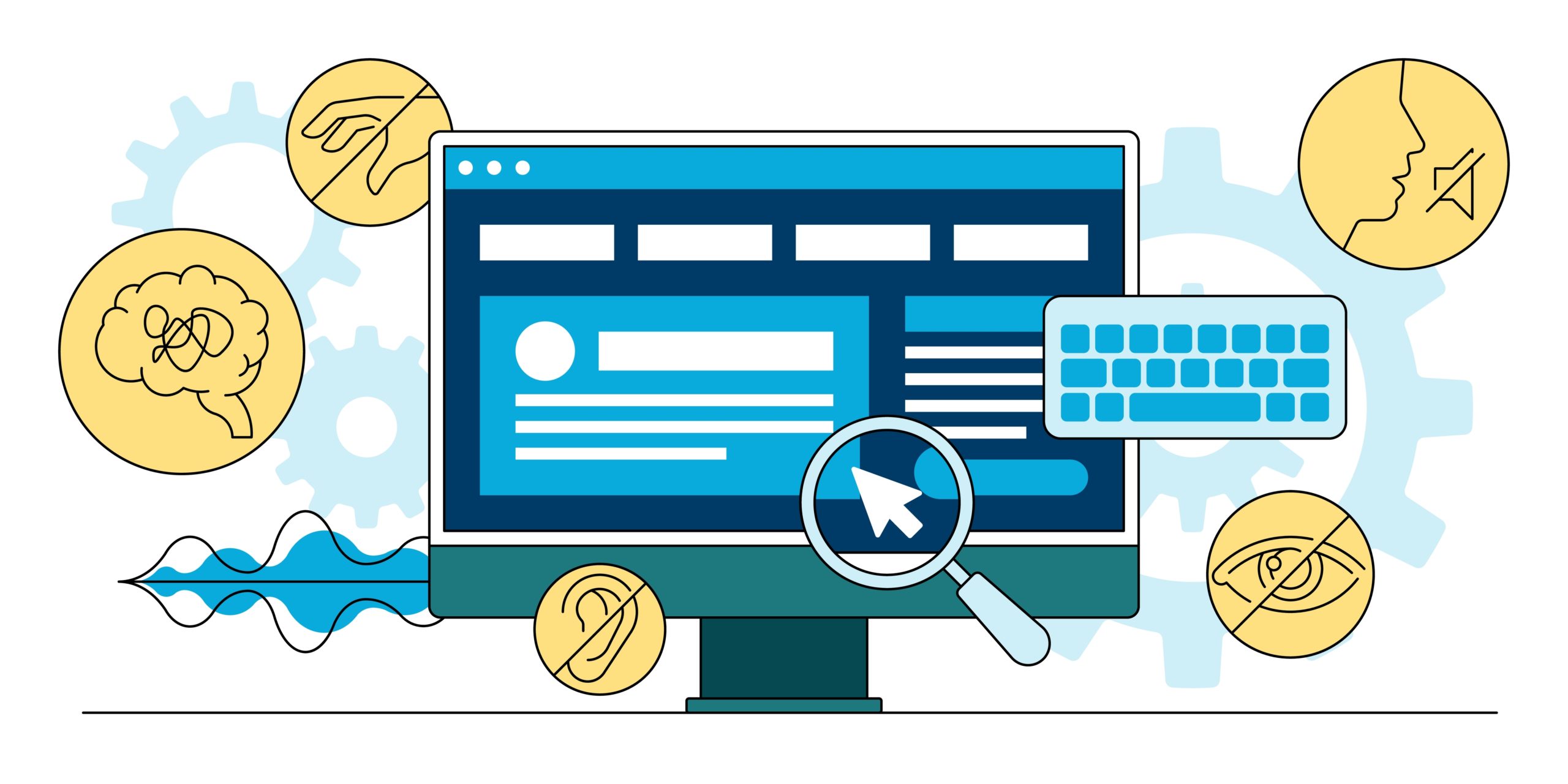Social inclusivity has become a crucial issue, and many organizations and advocacy groups are looking for ways to stop discrimination against people experiencing social exclusion.
But what about digital environments? With 15% of the global population living with some form of disability, inclusivity in online experiences is more than a trend.
Take web design, for instance. There are probably thousands of people who visit your website but can’t navigate through it. So, what does that leave you with? Millions of lost opportunities to impress them, address their challenges, and build long-term relationships. That is why businesses are starting to focus on creating an equal web browsing experience for all users.
But the truth is that we have a long way to go for inclusive web design to become the new normal. Most marketers appear reluctant to implement inclusive design tactics, thinking it’s time-consuming and expensive. In this article, we will tackle this popular belief by sharing all there is to know about inclusive web design, why you need it, and the best practices to do it right.
What Is Inclusive Web Design?
Inclusive web design is the practice of considering the specific needs of users that experience exclusion in different ways because they belong to a minority group. Design inclusivity doesn’t just include people with permanent disabilities, but also oppressed groups or any user who experience restrictions or exclusions when interacting with digital products.
Being a UX professional, you’re faced with the responsibility of creating products that are accessible to everyone. Whether it’s how to build your company blog or how you create a landing page and regardless of the type of restrictions visitors face, accommodating everyone’s browsing needs shouldn’t come as an afterthought. Having said that, we shouldn’t confuse inclusive design with accessibility practices since it’s much more than that.
Inclusive Web Design vs. Accessible Web Design
There’s a common misconception that inclusive web design is the equivalent of accessible web design. Accessibility and inclusivity in design may go hand in hand, but they are not the same. Inclusive web design is an umbrella term that entails accessibility methods, which involve making digital products easy for people with disabilities to understand. Inclusivity extends to other factors such as technical constraints, language, and demographic barriers or any type of situational limitations that disable users from fully engaging with web pages.
When we talk about inclusive design, we actually mean universal design that addresses any type of limitation, from people using a small screen or slow internet connection to people with temporary disabilities like an arm injury. Inclusive design isn’t limited to delivering accessible and easy-to-use solutions, but more importantly, it should make people feel appreciated.
To cut a long story short, inclusive web design is more about how to approach designing for diversity rather than the outcome per se.
Essential Pillars of Inclusive Web Design
To build inclusive digital products, designers need to create experiences that meet every user’s needs and circumstances. Therefore, it’s crucial to adopt an inclusive design mindset from the beginning.
Let’s examine the pillars of inclusive design that you need to keep in mind.
- Identify the types of exclusion. Before kicking things off, search for points of exclusion and leverage them as starting points for creating new and more inclusive options. When designers figure out how and why individuals feel excluded, it’s easier to create a roadmap toward inclusive digital experiences.
- Involve users. Users should be at the center of every digital solution. For designers to know what different user groups value, involving them should be a priority. This becomes even more important for groups designers don’t know much about. So, ask for their opinion to discover their changing needs and test ideas based on their input to deliver experiences they appreciate.
- Stay away from personal biases. Include users from different backgrounds and communities to avoid personal biases getting in the way of designing equitable solutions. This will help you become aware of who you’re leaving out of the design process.
- Start with your team. The first step to avoiding biases is starting with your own team. Having an inclusive workforce not only helps you realize your personal biases but also overcome them. A design team made of people with different backgrounds and abilities is the key to unlocking a wider range of user challenges.
Why is inclusivity a must-have in web design?
User needs are diverse. So, assuming a one-size-fits-all approach will likely result in disaster. Additionally, inclusive development in web design helps you establish yourself as an industry leader and outperform your competitors.
Let’s break down the most important reasons to adopt an inclusive mindset when designing digital products.
1. Reach a larger audience
The social impact left aside, inclusive web design is crucial from a business perspective too. It goes without saying that you will lose customers if you leave large portions of your audience out. Inclusive features like translation options, visual components, or voice assistants help you reach a larger audience and enhance inclusivity in your website design. Keep your focus on building a universally positive experience, and users will reward you with their loyalty.
2. People expect it from you
Social media platforms have turned a spotlight on social injustices, so users today are more socially aware than ever. People expect businesses to shift toward inclusion because it’s the right thing to do. That’s why including people with different needs and abilities is more than a business decision.
When you don’t do everything within your power to include users, you exclude them from engaging with your products, even unintentionally. Now is the time to design for diversity since it impacts whether users will choose to turn into customers or not.
3. Solve different problems at the same time
Every website visitor has interests and motivations, as well as limits to their abilities based on various circumstances. As a result, every one of us might experience exclusion while interacting with web design. That’s where inclusive design can connect different users with different limitations in similar ways. For example, large clean text benefits people with poor eyesight, but it also helps drivers and other people who browse while in motion.
4. Build brand awareness
Consumers love brands that make their lives easier, and nothing indicates that intention more than inclusive design elements. Internet users have shorter attention spans and spend more time on various screens. Therefore, problems like carpal tunnel syndrome or computer vision syndrome are more common than we think. These people prefer visiting websites that they can easily navigate on any device.
When you design your website with inclusivity in mind, visitors feel welcomed and comfortable with the customer journey you offer them. That way, your brand stays top of mind and has a competitive advantage.
5. It improves your SEO
Search engines prefer web pages optimized for a better user experience and inclusion features. If you don’t keep up with accessibility best practices, a compelling website will do you no favors in terms of SEO.
Many marketers tend to overlook usability and accessibility on their websites. However, it’s a bulletproof way for search engines to notice websites and improve their ranking. Not only do you keep Google satisfied by aligning with its search algorithm, but you also offer the best on-page experience to visitors.
8 Inclusive Design Best Practices
Designing more inclusively might get frustrating since it’s hard to evaluate if your web page offers an equitable online experience. If we have to pick a starting point, that is letting go of every assumption, as well as deciding to favor all users instead of just the average one. To succeed in making everyone feel included, read along to discover the best practices to follow as a designer.
1. Create well-structured, readable content
Your website content is an integral part of your content marketing strategy. Readable and carefully structured content is key to keeping visitors engaged.
Pick a structure that enables visitors with cognitive or visual disabilities to read it. You should also contain a logical sequence that guides users through your content and removes friction points.
Apart from those steps, there are simple changes that make a difference in how users interact with your content. Here are some key guidelines for readable and meaningfully sequenced content:
- Use simple language with short sentences to make your content easy to read and digest
- Break up long blocks of text into smaller sections and use headings, bulleted lists, and images to support users with vision or reading disabilities
- Include elements like accordions to hide content that distracts visitors from core content they need to access first
- Make sure you use an adequate amount of contrast between your content and its background
2. Keep Your Layout Clear and Simple
Hierarchy is as important with the layout as it is with content. Clear and minimal will never go out of style as a design trend, and for good reason, since visitors don’t appreciate messy designs with complicated navigation and chaotic information. Clear and simple layouts translate into intuitive, user-friendly, and visually appealing interfaces.
Make sure you build the core features of your website that highlight its usability without straying visitors away from the most relevant information. Then, you can add any necessary components to show value and engage them further.
3. Ensure Consistency
Being a designer, you already know consistency is vital for every digital product you create. That’s even more important when you design to include diverse audiences. Inconsistent designs usually confuse users and lead to them leaving your website. It’s even harder for people with cognitive disabilities, as they struggle through complex interfaces that don’t make sense.
Consistency in your website navigation improves easiness of use and can result in easier and faster conversions. But don’t get us wrong–consistency doesn’t mean predictability. So, ensure you only remove the elements that cause frustration while staying as creative as possible.
4. Use Alternative Text for Images
Savvy marketers know how visual elements like images, videos, or infographics grab attention while conveying feelings. But including images or videos on your website is useless if you don’t include alternative text and captions, respectively.
Screen readers rely on alt-text to describe images to people with vision impairments. Carefully crafted and brief descriptions help avoid misinterpretations by informing visitors what the image is about.
When you write alternative text for your images, here are some important aspects to consider:
- Describe what is happening in the picture briefly but accurately so that users access the most crucial information quickly
- Remember to include how the image relates to the surrounding environment
- When an image is mostly decorative, use an empty <alt> field for screen readers to know they can skip that image
Also, don’t forget to include captions for your video content for people with hearing difficulties to grasp your video content. Make sure you provide captions for every video featured on your website for users to understand your message fully. Lastly, whatever you do, don’t put your videos in autoplay since it increases user cognitive load.
5. Opt for Inclusive Copy
A mistake many marketers make is neglecting copy in favor of visuals. But words are our tools to express ourselves and create connections. The same goes for UX design. To open up to a larger audience, you need an inclusive and concise copy. Let’s review some tactics to implement for an inclusive copy:
- Opt for simple words and avoid complicated terms or unnecessary jargon. Doing so allows people with learning and cognitive disabilities to grasp your message.
- If you must use complex ideas or terms on your website, consider using images or videos to simplify things for users with disabilities or non-native speakers
- Be extra careful with the copy you include in online forms. It’s one of the most sensitive yet neglected parts of lead generation. Find out which questions you need to ask and how to do so, and be mindful of the answer options you provide.
- Exclude gender pronouns and gender-sensitive terms (e.g., “ladies and gentlemen”) to ensure all users feel accurately represented.
6. Pick Colors Wisely
Color plays a huge role in the design because it evokes emotions and attracts viewers’ attention. The problem is it comes with limitations since not all users perceive colors in the same way.
For example, people with red-green color blindness have trouble seeing shades of green and red. On top of that, visitors from different cultural backgrounds interpret colors differently, which could affect their understanding of your content. For example, visitors with low vision or color blindness may have trouble understanding pie charts that present data in the form of color differences.
What can you do to avoid this distress among your visitors? Don’t rely on color as the only visual cue but try to incorporate elements like labels, icons, or bolded text. Moreover, avoid using highly contrasting colors and putting similar colors side by side. Such small things make users comfortable using your website while bridging differences between diverse audience groups.
If you don’t know where to start, you can use tools like Color Safe or WebAIM that generate accessible color combinations for you.
7. Don’t Forget About Keyboard Accessibility
One of the key components to test when designing your website is keyboard accessibility. If you don’t optimize your website for keyboard navigation, you give visitors with visual or motor impairments a hard time. Remember that a keyboard could be their only means to access your website and interact with its components.
But what does optimizing for keyboard navigation mean? Try going from left to right and up and down to make sure you can navigate through the web page while only using a keyboard.
Don’t forget to test how easy or difficult the navigation process is by simply using Tab. The Tab key is equally important for keyboard accessibility since it’s how keyboard-only visitors navigate web pages. The main idea behind this option is to offer them the ability to select every element on your page by clicking on the Tab key.
The Importance of Inclusivity
For many years, web design has been about creating compelling, colorful, and out-of-the-ordinary web pages that catch attention. And while those characteristics are still relevant, they are inadequate for giving visitors a truly enjoyable web experience.
Just imagine for a second that you create an eye-catching website. If you don’t build it with inclusive web design in mind, you’re preventing a large percentage of users from accessing it. Your end result should be a universal design received well by every user on every device.
Turning your website into an inclusive and equal space for all visitors isn’t as intimidating as it sounds. To succeed in it, you first need to have a solid understanding of the challenges different audience groups face when engaging with digital products.
Remember to follow the best practices shared in this guide to create usable and valuable websites. And, whatever you do, never stop keeping up with ever-evolving audience needs for inclusive and customer-centric digital experiences.
Here at Spiralytics, we specialize in user experience web design services that create an effective website for all.







